duet
Gabrielsky - Adagio et Variations - Fl & Pf
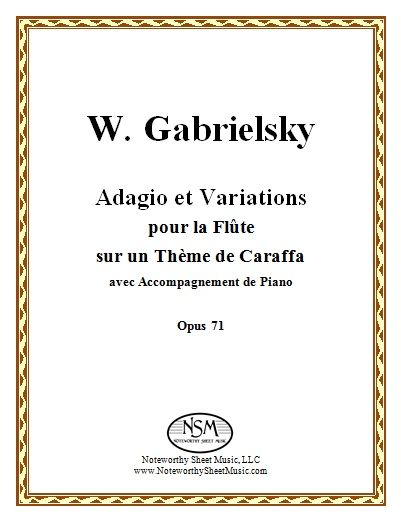 Adagio et Variations pour la Flûte sur un Thême de Caraffa, Op. 71, by W. Gabrielsky
Adagio et Variations pour la Flûte sur un Thême de Caraffa, Op. 71, by W. Gabrielsky
Gassett Collection - New Edition by Noteworthy Sheet Music
Flute Part and Piano Score, PDF $18.75
Johann Wilhelm Gabrielski (or Gabrielsky), 1795-1846, was an acclaimed German flutist and composer from Berlin. In 1814 Gabrielski secured a position as flutist at the theatre in Stettin and within two years was appointed to the Royal Court. Gabrielski's compositions, of which there are more than 100, were highly esteemed and popular in his day. Although these works have much to offer modern day flutists as well, Gabrielski's music is neither widely known nor readily available today. The Adagio et Variations pour la Flûte, Op. 71, exploits melodic material by Michele Enrico Carafa (Caraffa) di Colobrano (1787-1872), a Naples born musician who had a remarkably successful career in Paris as a composer for the Opéra-Comique and as a professor of composition and counterpoint at The Conservatoire. The work showcases the flutist's virtuosity, atop a relatively uncomplicated piano accompaniment.
For additional information about the Gassett Collection, please see see our article An Introduction to the Gassett Collection.
Flute part, 11 pages; Piano Score, 16 pages; Total, 31 pages.
PreviewGade - Fantasy Pieces - Alto Flute
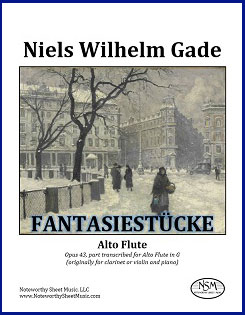 Fantasiestücke, Op.43, by Niels W. Gade
Fantasiestücke, Op.43, by Niels W. Gade
Transcribed for Alto Flute (and Piano) by John W. Pratt
Alto Flute Part, PDF $6.99
Niels Wilhelm Gade (1817–1890) became the preeminent figure in 19th century Danish musical life after an early success in Copenhagen and five years in Leipzig as Mendelssohn's assistant and successor. His Fantasiestücke (Fantasy Pieces, Opus 43) for clarinet (or violin) and piano were published in 1864, apparently his only work published that year although others were in progress. They are dedicated to the clarinetist "Herrn Kammermusiker Mozart Petersen." Our flute transcriptions take into account the nature of the flute and the discrepancies between Gade's original score and the clarinet and violin parts. We provide our alto flute part; the piano score is readily available in the public domain as a free pdf download of the score for clarinet and piano. Here is a link to one such source: Piano Score
Alto Flute part, 7 pages; Total, 10 pages.
PreviewGade - Fantasy Pieces - Flute
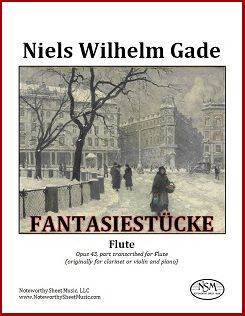 Fantasiestücke, Op.43, by Niels W. Gade
Fantasiestücke, Op.43, by Niels W. Gade
Transcribed for Flute (and Piano) by J. W. Pratt
Flute Part, PDF $6.99
Niels Wilhelm Gade (1817–1890) became the preeminent figure in 19th century Danish musical life after an early success in Copenhagen and five years in Leipzig as Mendelssohn's assistant and successor. His Fantasiestücke (Fantasy Pieces, Opus 43) for clarinet (or violin) and piano were published in 1864, apparently his only work published that year although others were in progress. They are dedicated to the clarinetist "Herrn Kammermusiker Mozart Petersen." Our flute transcriptions take into account the nature of the flute and the discrepancies between Gade's original score and the clarinet and violin parts. The piano score is readily available in the public domain, as a free pdf download of the score for clarinet and piano. Here is a link to one such source: Piano Score
Flute part, 7 pages; Total, 10 pages.
PreviewGaubert - Deux Esquisses - Clarinet and Piano
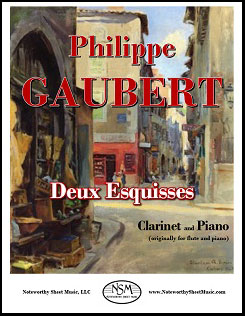 Deux Esquisses, by Philippe Gaubert
Deux Esquisses, by Philippe Gaubert
transcribed for Clarinet and Piano by C. A. Vater
Clarinet part and Piano score, PDF $9.99
Philippe Gaubert was a prominent French flutist, composer, and conductor who held a professorship at the Paris Conservatory and principal conducting positions at the Paris Opéra and the Orchestre de la Société des Concerts du Conservatoire. We’ve created a transcription of his Deux Esquisses (Two Sketches) for B♭ clarinet, complete with piano score. These pieces were written for flute and piano but are nicely adaptable for other winds. They were originally published by Heugel & Cie, in 1915 (No.1) and 1914 (No.2), and are now in the public domain. No.1, Soir sur la Plaine (Evening on the Plain), opens intriguingly with the solo instrument playing alone, repeating a single note. This motif sets the lovely, mysteriously forlorn tone of Soir sur la Plaine, and returns multiple times later in the piece. No.2, the second sketch, is Orientale, which, as its name suggests, evokes an atmosphere seemingly strange and foreign, Eastern.
Piano Score, 10 pages; Clarinet part, 4 pages; Total, 20 pages.
PreviewGlazunov - Chant du Ménestrel - trans. for A-Clarinet and Piano
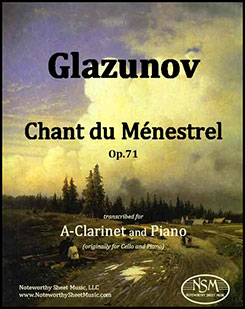 Glazunov - Chant du Ménestrel, Op.71, by Alexander Glazunov
Glazunov - Chant du Ménestrel, Op.71, by Alexander Glazunov
Transcribed for A-Clarinet and Piano by C.A.Vater
Score and Part; PDF $7.99
Alexander Glazunov (1865-1936) was an eminent composer in the late Russian romantic tradition. In 1901, he published two versions of his Chant du Ménestrel, one for cello and orchestra and another for cello and piano, dedicating the work to Alexandre Wierzbilowicz, principal cello at the Russian Imperial Opera Orchestra and a professor at the Conservatory. Chant du Ménestrel (Minstrel’s Song) is a sorrowful, romantic piece that evokes the image of a Russian troubadour wandering the countryside, singing his sad songs. The lyrical, expressive solo cello line is without double stops and readily transcribed for other instruments. Written in the key of F# minor, this short work (average duration 3-4 minutes) adapts especially well for A-clarinet.
Score, 4 pages; A-Clarinet part, 2 pages; Total, 10 pages.
PreviewGlazunov - Elegy - Flute or Alto Flute
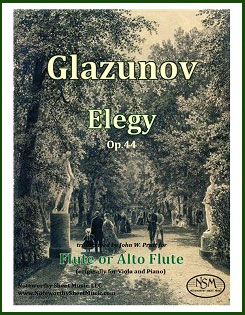 Elegy, Op.44, by Alexander Glazunov
Elegy, Op.44, by Alexander Glazunov
Transcribed for Flute or Alto Flute (and Piano) by John W. Pratt
Parts for Flute and Alto Flute, PDF $5.99
Alexander Konstantinovich Glazunov (1865-1936) was a major composer in the late Russian romantic tradition. His Elegy, Op.44, was written for viola and piano in 1893. The viola melody is readily adaptable for other instruments, since it is without double stops, and has been transcribed here by John W. Pratt for either flute or alto flute. The piece is about 6 minutes long, elegiac but not lugubrious. It consists of a lovely melody in 9/8 time, enhanced by a simple but warm piano accompaniment. The NSM edition includes a flute part and an alternative alto flute part, but does not include one for piano, since a suitable score is freely available at IMSLP.org.
Flute part, 2 pages; Alto Flute part, 2 pages; Total, 8 pages.
PreviewGlazunov – Elegy – Clarinet
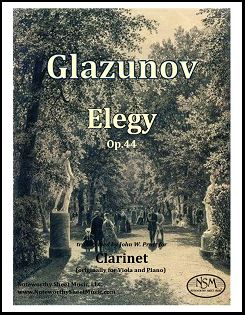 Elegy, Op.44, by Alexander Glazunov
Elegy, Op.44, by Alexander Glazunov
Transcribed for Bb Clarinet (and Piano) by John W. Pratt
Clarinet Part — PDF $3.99
Alexander Konstantinovich Glazunov (b. St. Petersburg, 1865; d. Paris, 1936) was a major composer in the late Russian romantic tradition. His Elegy, Op.44, was written for viola and piano in 1893, and has been transcribed by John W. Pratt for Bb clarinet. The piece is about 6 minutes long, elegiac but not lugubrious. It consists of a lovely melody in 9/8 enhanced by a simple but warm piano accompaniment. The viola melody is readily transcribed for other instruments, since it is without double stops. The piano part is freely available at IMSLP.org.
Clarinet part, 2 pages; Total, 6 pages.
Goepfart - Zwei Charakterstücke - Alto Flute and Piano
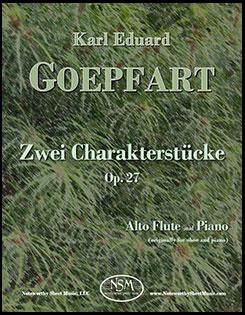 Zwei Charakterstücke, by Karl Eduard Goepfart
Zwei Charakterstücke, by Karl Eduard Goepfart
transcribed for Alto Flute and Piano by C. A. Vater
Alto Flute part and Piano score, PDF $8.99
Karl Eduard Goepfart (1859-1942) was a German pianist, composer and conductor. His Zwei Charakterstücke, Op. 27 (Two Character Pieces) were written for oboe and piano and first published in Leipzig in 1888. The two contrasting pieces are the very charming Mässig schnell, gehend and Mässig langsam (in ruhiger Bewegung) with its playful, energetic Lebhaft section. We prepared a transcription of this under-appreciated work for alto flute, complete with piano score. The pieces work well on alto flute, providing the accompanying pianist is sensitive to the alto flute’s lower sound power and projection capability, especially in the low register, compared to that of the oboe.
Piano Score, 8 pages; Alto Flute part, 3 pages; Total, 16 pages.
PreviewHauptmann - Bereavement - Alto Flute & Piano
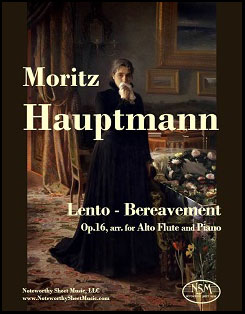 Lento - Bereavement, by Moritz Hauptmann
Lento - Bereavement, by Moritz Hauptmann
Transcribed for Alto Flute and Piano by C. A. Vater
Piano Score and Alto Flute Part, PDF $3.99
Hauptmann's 3 Violin Duos, Op.16 were first published in 1832. The Lento (Bereavement) from Op.16 later was arranged for violin and piano by the renowned violinist, violist, and composer Heinrich Wilhelm Ernst. It is this arrangement by Henri Ernst, published in 1880, that served as the basis for NSM’s transcription of the piece for alto flute and piano. The mournful simplicity of the Lento is perfectly captured and beautifully rendered by the alto flute.
Alto Flute part, 1 page; Piano Score, 2 pages; Total, 6 pages.
PreviewHaydn - Adagio from Sym. No.24 - Afl & Pf
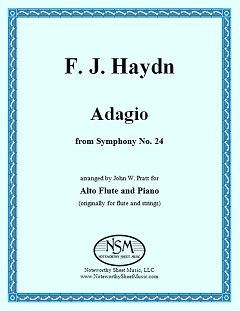 Adagio from Symphony No.24, by F. J. Haydn
Adagio from Symphony No.24, by F. J. Haydn
Arranged for Alto Flute and Piano by John W. Pratt
Alto Flute Part and Piano Score, PDF $6.00
We offer a flute and piano edition of the gorgeous second movement Adagio for solo flute accompanied by strings from Haydn's Symphony No.24. An arrangement for alto flute that is mellower than that for flute but also extremely beautiful is obtained by lowering the pitch a minor third. Haydn's flute part needs no other change, nor does the cadenza that was written by Mr. Pratt for our C-flute edition. The string parts have been adapted to piano sonority in a number of ways, as well as transposing them in this alto flute edition.
Alto Flute part, 2 pages; Alto Flute & Piano score, 4 pages; Total, 10 pages.
Preview